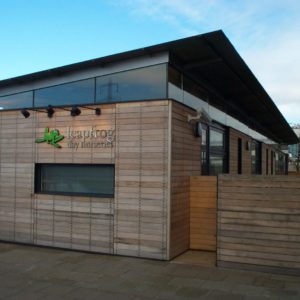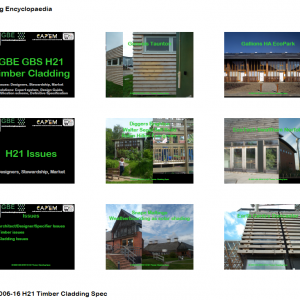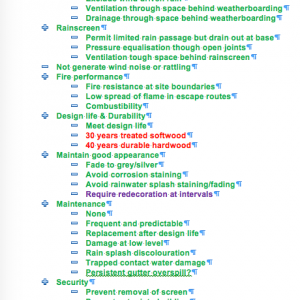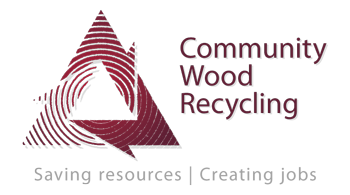
GBE H21 Timber Weatherboarding Checklist
GBE > Encyclopaedia > Code > Checklist > G#9439
GBE H21 Timber Weatherboarding Checklist
Issues:
- Timber is a natural material with natural variation and an amazing range of properties and applications
- Standards are being kept up to date and familiar British Standards are being replaced by unfamiliar Euro Norms
- It is relatively easy to get out of date and get specifications wrong
- TRADA employs one man full time to address the many calls from Architects with failed timber weatherboarding
Problems:
- There are too numerous problems to describe here now (but I will keep coming back to add more)
- Despite NBS Guidance enabling competent specification of Timber Weatherboarding
- Users of NBS still get it wrong from time to time
- Poor detailing, poor specification, poor choice of timber, substitution and poor workmanship and maintenance all contribute to failures.
Example:
- BRE Campus’ Innovation Village, one demonstration building had failed timber weatherboarding where two adjacent boards expanded then burst out of the cladding surface.
- The T&G joints had been installed upside down creating a channel to collect water, the boards absorbed water and expanded until failure. That demonstration building is gone now.
Misunderstandings:
- If an architect chooses to do ‘radical timber weatherboarding’ and the detailing is questioned by the tradesman the Architect should learn to listen and not insist on his details be followed without question.
Solutions:
- Don’t be radical for the sake of being radical; learn to be competent instead
- Subscribe to NBS and use H21 Timber Weatherboarding Specification read and use the guidance notes carefully
- Purchase the TRADA Book on Timber weatherboarding, read it and follow its guidance
- Consider using the GBE H21 Timber Weatherboarding (Outline), read it and follow the guidance
- Use askTRADA website
- Seek TRADA advice/consultancy
- Purchase the more technical Napier University Book on Timber Weatherboarding, read it and follow its guidance
- If you want to do open joint rain screen weatherboarding, consider using the following specification and editing to suit your project GBS H21 Timber Weatherboarding Rain screen (RSWS)
- Listen to the tradesman
GBE Outlines
- GBE H21 Timber Weatherboarding (Outline) G#10281
GBS Specification
- GBS H21 Timber Weatherboarding (RSW) G#625
Consider:
- Durable species without preservative treatment
- Locally sourced durable softwood or hardwood
- Unseasoned, untreated, unfinished oak can be as cheap as treated softwood
- Architect to design joinery to minimise waste, be aware of position in log, sections sizes and lengths, before deciding use and joint patterns of hardwoods
- FSC approved timber sources, timber board products and timber based materials See G20, Z10
Substitute:
- Architects are prone to choose their favourite species of timber; availability of the species varies in the supply chain, due to numerous issues including:
- Long growing time
- Seasonal harvesting
- Drying/Seasoning time
- Availability, stock levels and delivery times
- Matching quantity available to size of project
- Reclassification of scarcity and endangerment, etc.
- FSC timber or other Certification scheme requirements
- Some favourite species have the wrong characteristics for some application
- Most species unfinished and exposed to the sun will fade to silver/grey so the original colour becomes irrelevant
- There is a growing preference for timber species to be specified by performance characteristics and colour range
- enabling legal and sustainable timber to be sourced with chain of custody more readily
- offering a few examples of species available with characteristics that match the requirements
- leaving the final species choice to the Architect by samples
Minimise:
- Timber miles shipping tropical hardwoods to the construction site
Avoid:
- Preservative treatment by choosing species for durability to match the application
- Treated softwood if a durable softwood is available
- Treated softwood if a durable hardwood is available
- Transporting durable hardwoods cross the globe if a local durable hardwood will do the job
- Indonesian Hardwood
- Recently most has been illegally logged, destroys forests, biodiversity, communities and habitation
- Only use FSC certified
- Preservative treated perishable softwood. See G20, Z10 and Z12
- PVC substitute for timber cladding See Z50
- Coated aluminium substitute for timber landing
- Virgin Plastics See Z50
Health:
- Avoid the use of preservatives which need touching up on site wherever the timber is cut or drilled on site
Environmental:
- Avoid the use of preservatives, they are hazardous if released to the environment (air, land or water) or to nature
Wellbeing:
- Use unfinished untreated timber in preference to treated, painted, stained, oiled, waxed timber, any of which may off-gas VOCs to the environment
- The smell of fresh paint is often welcomed but it invariably is not making your health better
- Recent (2011) changes to EU Directives saw a significant reduction in VOC releases from paint to the atmosphere but this does not mean they are all gone.
- Low-VOC can also mean more/different chemicals to limit VOC releases to atmosphere
- There are many manufacturers who have always made VOC-free natural plant-based or mineral-based paints
Biophilia:
- Being able to see, feel, hear and even smell timber is very welcome by most occupants, visitors and passers-by
- There is growing evidence that natural materials in the built environment can enhance their sense of wellbeing
Biodiversity:
- Designing for Biodiversity: A Technical Guide for New and Existing Buildings G#1328 N#1316
- This guide includes how to incorporate bat boxes in the timber weatherboarding cladding zone without compromising the building’s external envelope.
Safety:
Precautionary principle:
- Avoid using preservative treatments to avoid risk of loss to the environment and nature
Resourceful:
Resource Efficiency:
- Architect to design joinery to minimise waste: be aware of position in log, sections sizes and lengths, before deciding use and joint patterns of softwood and hardwoods
- Choose and reserve the log with the right amount of figuring (more or less), for your project,
- don’t condemn the installation with too much or too little figuring
- Avoid sending finished materials to landfill
Industry/Sector Initiatives:
- Consider having excess to requirement collected by one of the nationwide social enterprise sites
Reduce:
Reclaim:
- Reclaimed cladding timber: Supplier:
- Architectural Salvage: via Salvo website Salvo
- Construction reclaim: via Community Wood Recycling
Reuse:
- Offer ‘excess to requirements’ materials to exchange websites
Recycle:
- Recycling of timber usually means reducing to wood chips or particles and adding a synthetic binder to make chipboard or particleboard, with or without other salts for fire or preservative treatments
- Recycling of timber can also mean reducing to wood flour and adding recycled plastics to make a conglomerate wood-plastic
- C2C or Cradle to cradle principles advise against mixing technical (plastics) and natural (wood) since separating them at the end of life is currently economically nearly impossible and are likely to end up in landfill, with a shorter than plastic life and a longer than timber life
Recover:
- Consider heat recovery if burning untreated and unfinished timber on site
- Use damaged untreated pallets to construct on-site composting bins to compost landscape waste
Use/Maintenance
In Use Issues:
Maintenance issue:
Visible face fixed fasteners can enable:
- Ease of build ability
- Out of sequence building or completion
- Ease of replacement
- Ease of demount-ability
- Ease of reclaim ability
- Ease of reusability
Systems:
GBE Systems
Waste issues:
Waste Issues:
- Waste Statistics: 30 m tonnes (33% of 90 m. tonnes/year) of waste is offcuts
- (not all timber, not all H21)
Waste Classification:
- Untreated timber: Active (Biodegradable)
- Treated timber: Inert but Hazardous
Hazardous waste:
- Preservative treated timber is hazardous waste
- Do not burn on site, nor permit it
Deleterious Substances:
- Waste preservative treatment
- Waste paints & stains
Waste statistics:
- Waste Statistics: 30 m tonnes (33% of 90 m. tonnes/year) of waste is offcuts
- (not all timber, not all H21)
Waste minimisation:
- Architect to design joinery to minimise waste
- be aware of position in log, sections sizes and lengths
- before deciding use and joint patterns of hardwoods
- Avoid water staining of timber due to stacking outside in inclement weather
Waste management:
- Offer ‘excess to requirements’ to material exchange websites
End of Life:
End of Life options:
Demount-ability:
Visible face fixed fasteners can enable:
- Ease of build ability
- Out of sequence building or completion
- Ease of replacement
- Ease of demount-ability
- Ease of reclaimability
- Ease of reusability
Remanufacture:
Recycle:
GBE Jargon Buster
- Timber
Initial, Abbreviations & Acronyms
- HW
- SW
- H21
- CCA
- OS
- Z20
- Z21
Classification
- Durability
- Hardwood (HW)
- Indigenous
- Organic Solvent (OS)
- Pressure equalisation
- Rainscreen Cladding
- Softwood (SW)
- Temporate
- Timber Weatherboarding
- Tropical
GBE Checklist(s)
- H21 Timber Weatherboarding (Checklist) G#11946
Refurbishment
- H21 Timber Weatherboarding (Checklist) G#11946
CPD/Lectures:
GBE CPD
- Refurbishment
- Housing
- Non-Domestic
- GreenDeal
- GBE CPD H21 Timber Weatherboarding (Shop) G#11855
GBE Lectures
Theme
- Elemental
Subjects
- H21 Timber Weatherboarding (Project) G#549 N#569
- GBE Lecture (21) Timber External Walls (Shop) G#11557
- GBE CPD H21 Timber Weatherboarding (Shop) G#11855
GBE Shop
- GBE Lecture (21) Timber External Walls (Shop) G#11557
- GBE CPD H21 Timber Weatherboarding (Shop) G#11855
Case Studies:
GBE Case Studies
Portfolio
- Leapfrog Day Nursery Royal Docks East London (CaseStudy) G#11864
- H21 Timber Weatherboarding (Project) G#549 N#569
GBE Evidence Based Case
Buildings
GBE Projects
- H21 Timber Weatherboarding (Project) G#549 N#569
- GBE CPD BIM A Spec Writers Perspective (Shop) G#11814
GBE Calculators
Equations
- GBE Timber Species Schedule G#1371 N#1351
- Timber Species Schedule (Shop) G#10656
Product Data Sheets
- GBE Whole building Embodied Sequestered Energy Carbon calculator G#1904 N#1761
- GBE Whole Building EE EC SC Calculator G#1910 N#1764
- GBE Whole Building EE EC SC Calculator updated N#1763
- GBE Calculator Whole Building EE EC SC A11 XLS (Shop) G#11090
- GBE Calculator Whole Building EE EC SC A10 XLSX (Shop) G#10445
By other:
- 12/02/2013: ShapedEarth Building Embodied Carbon N# 1298
- 10/04/2014 UK Embodied Carbon DataBase launched N#1432
Ambitions:
- Proposal for a timber merchant to create Embodied and Sequestered Carbon calculator
GBE Products
All
Build
Interior
Infrastructure
Services
Landscape
Recycled
GBE Accessories
GBE CPD
- CPD Covers
- CPD Slides
- CPD Shows
- GBE CPD H21 Timber Weatherboarding (Shop) G#11855
- CPD Handouts
GBE Images
© GBE GBC GBL NGS ASWS Brian Murphy aka BrianSpecMan **
21st January 2016 – 14th June 2021








